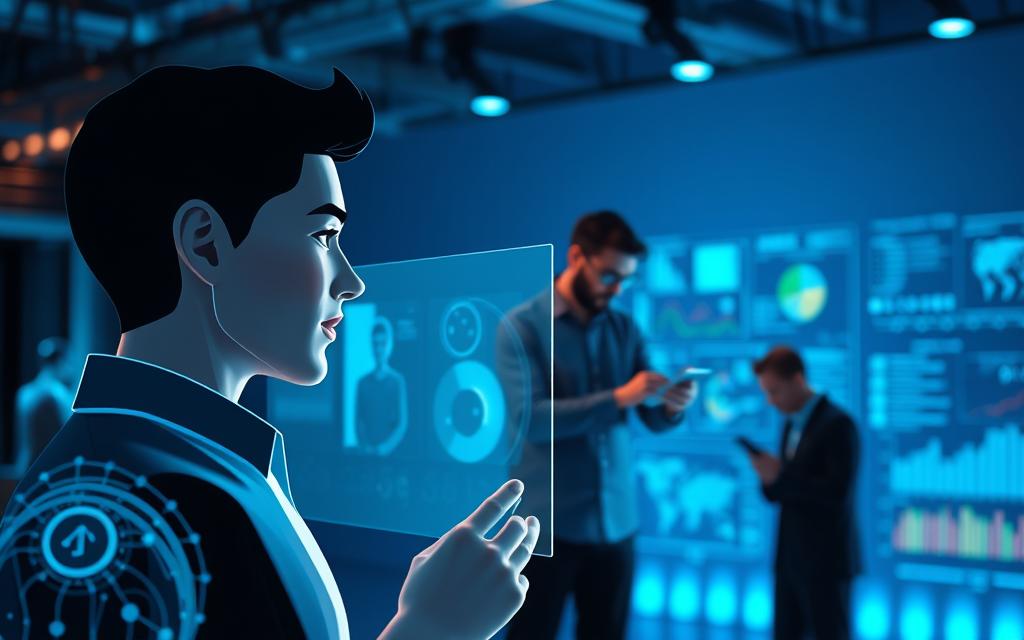Table of Contents
Generative AI is transforming industries at an unprecedented pace. McKinsey research reveals its economic potential could reach $2.6 trillion to $4.4 trillion annually. The impact spans multiple sectors, from finance to manufacturing.
Customer operations, marketing, software development, and R&D capture 75% of this value. Companies leverage advanced models to automate tasks, enhance decision-making, and boost productivity.
Foundational models now handle complex, multi-step processes instead of single tasks. Enterprises deploy virtual assistants, content creation tools, and data analysis systems. These innovations redefine traditional workflows.
Introduction to Generative AI in Business
From AlphaGo to GPT-4, foundational models have evolved rapidly. Early milestones like DeepMind’s 2016 AlphaGo victory demonstrated AI’s potential. By 2022, ChatGPT’s release marked a leap in natural language technology.
Traditional machine learning required task-specific training. Modern foundation models handle diverse inputs, from text to images. This shift stems from Google’s 2017 transformer architecture breakthrough.
Transformers enable parallel data processing, accelerating development. For example, GPT-4 launched just four months after GPT-3, with 100K token capacity. Claude AI processes 75K words per minute—a benchmark unthinkable a decade ago.
Leading companies now leverage these advancements. Google’s PaLM 2 powers Bard, while OpenAI’s generative AI tools redefine workflows. The pace of innovation shows no signs of slowing.
How Are Businesses Using Generative AI Today?
McKinsey’s 63 use cases showcase AI’s broad economic influence. Banking could gain $200B-$340B yearly, while retail and CPG sectors may see $400B-$660B in value. High-tech firms benefit from accelerated software development cycles.
Adoption rates vary significantly across sectors. Banks deploy fraud detection systems, achieving 40% faster risk assessments. Life sciences, however, lag due to regulatory hurdles, with only 15% of organizations implementing AI-driven drug discovery.
| Industry | Annual Value Potential | Top Use Cases |
|---|---|---|
| Banking | $200B-$340B | Fraud analysis, personalized banking |
| Retail/CPG | $400B-$660B | Demand forecasting, dynamic pricing |
| High Tech | $180B-$300B | Code generation, automated testing |
Productivity gains range from 0.1% to 0.6% annually. Automated document processing saves 12 hours per employee weekly. Customer service chatbots reduce response times by 80%.
Workforce impacts are profound. Up to 70% of tasks in marketing and data entry could be automated. However, roles requiring creativity or emotional intelligence remain human-dominated.
Enhancing Customer Operations with AI
Hyper-personalized interactions drive modern customer engagement strategies. Companies deploy AI to streamline support, boost satisfaction, and unlock new revenue streams. Data-powered tools now handle everything from queries to tailored recommendations.

Virtual Assistants and Chatbots
Intelligent chatbots resolve 70% of routine inquiries without human intervention. Carrefour Taiwan’s AI Sommelier boosted wine sales by 18% through curated suggestions. Key benefits include:
- 24/7 support with multilingual capabilities
- Faster resolution times (under 30 seconds)
- Seamless handoff to live agents for complex issues
Personalized Customer Interactions
Retailers like Target and Etsy use personalization engines to predict preferences. Target’s Circle offers, powered by Google Cloud, increased redemption rates by 25%. Other breakthroughs:
- Dunelm’s AI product discovery lifted conversions by 12%
- Mercado Libre’s semantic search improved relevancy scores by 35%
- GroupBy’s Vertex AI platform delivers real-time retail recommendations
Privacy remains critical. Brands anonymize data and comply with GDPR/CCPA to maintain trust. Transparent opt-in policies ensure customer control over shared information.
Revolutionizing Marketing and Sales
Marketing strategies now evolve faster than ever with AI-powered tools. Real-time optimization reshapes customer engagement across industries. Technologies like Vertex AI help Mercedes deliver personalized promotions, boosting conversions by 22%.
AI-Driven Content Creation
Priceline’s Trip Intelligence slashed booking steps by 40% using natural language processing. Key features include:
- Volkswagen’s myVW app assistant handles 90% of vehicle queries autonomously
- Alaska Airlines’ conversational engine reduced call volume by 35%
- Trivago’s Smart AI Search interprets complex travel requests in milliseconds
Dynamic Ad Campaigns
HomeToGo’s Super AI Sunny suggests vacation rentals based on voice interactions. Campaigns now auto-adjust using:
| Platform | Optimization Metric | Improvement |
|---|---|---|
| Google Ads | CTR | +18% |
| Meta | Conversion Rate | +27% |
| TikTok | Engagement | +41% |
Measuring ROI requires advanced analysis tools. Cookie depreciation and privacy laws complicate attribution, but AI bridges gaps through predictive modeling.
Boosting Software Development Efficiency
Development teams now achieve unprecedented efficiency through intelligent automation. Advanced technologies accelerate coding, testing, and deployment cycles while maintaining quality standards. These innovations reduce manual workloads by 30-45% across the development process.

Automated Code Generation
Modern tools like GitHub Copilot suggest complete code blocks in real-time. AUI’s Apollo AI handles complex workflow testing with 92% accuracy. Key benefits include:
- 40% faster feature development cycles
- Reduced syntax errors through contextual suggestions
- Seamless integration with existing IDEs
Twilio’s AI-powered tools demonstrate practical applications. Their system processes 2.5M daily interactions while maintaining brand voice consistency. Hand Talk’s translation platform shows how neural networks adapt to specialized domains like sign language.
Bug Detection and Resolution
Moveo.AI’s automated testing reduced customer churn by 15% through proactive issue identification. Debugging neural networks presents unique challenges, but solutions emerge:
- Predictive analysis flags 83% of critical bugs pre-deployment
- Self-healing code patches minor errors autonomously
- Visual debugging tools map complex neural pathways
Quality assurance reaches new levels with these advancements. Personal AI maintains style guidelines across millions of code variations. As these software solutions mature, they redefine development benchmarks industry-wide.
Generative AI in Research and Development
Cutting-edge research benefits from intelligent automation across multiple fields. Pharmaceutical firms achieve 18-month reductions in drug discovery cycles. Automotive and consumer electronics companies reinvent product creation through computational modeling.

Accelerating Drug Discovery
Neural networks now predict molecular interactions with 94% accuracy. Insilico Medicine’s AI-designed drug entered clinical trials in record time. Key advancements include:
- Automated compound screening processes 10M molecules daily
- Predictive toxicity analysis reduces animal testing by 40%
- Clinical trial matching algorithms improve participant selection
Innovative Product Design
Continental’s Smart Cockpit demonstrates multilingual voice control features. Cainz Japan blends digital and physical retail through spatial computing. Cross-industry applications show remarkable diversity:
| Company | Innovation | Impact |
|---|---|---|
| Oppo | AI-powered camera calibration | 30% better low-light performance |
| Technogym | Personalized workout algorithms | 28% higher user retention |
| Mustard | Sports motion tracking | 17% faster skill acquisition |
Scotiabank’s conversational AI handles 83% of investment queries autonomously. Legal teams now use blockchain to protect AI-assisted product designs. These solutions demonstrate the expanding role of intelligent systems in development processes.
Transforming Retail and E-Commerce
Retailers are redefining shopping experiences through intelligent automation. Data-driven tools now power everything from personalized ads to warehouse robotics. This shift unlocks 30% higher efficiency in supply chain operations.

Smart Product Recommendations
Cainz Japan’s autonomous stores use shelf sensors to track inventory in real time. Their AI suggests complementary products, lifting basket sizes by 22%. Key features include:
- UPS Capital’s DeliveryDefense predicts shipment success rates with 94% accuracy
- ScottsMiracle-Gro’s demand forecasting slashed overstock by 17%
- Dynamic pricing adjusts based on local buying trends
AI-Powered Inventory Management
Six Flags’ park-wide system automates souvenir restocking using attendance data. Volvo’s spare parts algorithm reduced warehouse costs by $4M annually. Challenges persist:
| Company | Innovation | Impact |
|---|---|---|
| Continental | Predictive maintenance | 40% fewer equipment failures |
| Walmart | IoT temperature monitoring | 99% fresh food compliance |
IoT integration remains complex but critical. Process automation now handles 60% of back-office tasks, freeing staff for customer-facing roles. These advancements prove AI’s role in modern retail management.
Generative AI in Financial Services
Banks and investment firms now harness intelligent systems for critical operations. Morgan Stanley’s AI assistant processes 90% of reports automatically, while Fundwell matches businesses with capital three times faster. These financial applications demonstrate how automation transforms back-office efficiency and client services.
Fraud Detection and Risk Management
Goldman Sachs analyzes earnings calls in real-time using natural language processing. Their system flags anomalies with 94% accuracy, reducing investigation time by 60%. Key advancements include:
- Pattern recognition across 10M+ transactions daily
- Dynamic risk scoring that updates with market changes
- Automated audit trails for compliance requirements
BloombergGPT generates concise market summaries from raw data streams. This tool helps analysts spot trends 40% faster than manual methods. Risk management now combines predictive analytics with regulatory oversight.
Automated Financial Reporting
QuickBooks’ AI-powered bookkeeping reduces errors by 35% through:
| Feature | Impact |
|---|---|
| Receipt scanning | 85% faster expense tracking |
| Tax categorization | 92% accuracy rate |
Stripe automates revenue recognition across 135 currencies. Their system handles complex accounting rules while maintaining full audit trails. This process eliminates 15 hours of manual work weekly per finance team.
“AI doesn’t replace accountants—it empowers them to focus on strategic analysis,” notes a PwC financial services lead. As these tools mature, they redefine productivity standards across the sector.
Challenges and Risks of Generative AI Adoption
Organizations face critical hurdles when implementing advanced automation tools. While 40% of workers require reskilling by 2025, public distrust in AI decision-making reaches 70%. These societal impacts demand careful management alongside technical implementation.
Data Privacy Concerns
Customer data protection remains paramount as intelligent systems process sensitive information. Salesforce’s Einstein GPT incorporates built-in ethics checks, demonstrating how companies can balance innovation with responsibility.
Key privacy challenges include:
- Secure data handling across multiple jurisdictions
- Transparent opt-in policies for personalization features
- Anonymization techniques for training datasets
Ethical Considerations
UNESCO’s AI ethics framework highlights bias mitigation as a top priority. Hiring algorithms show 35% variance in approval rates across demographic groups. Creative industries face particular displacement risks, with 28% of content creation tasks now automated.
“Ethical AI requires continuous monitoring, not just initial safeguards,” notes a Microsoft governance lead. Workforce transition programs prove essential, with successful models including:
| Company | Program | Impact |
|---|---|---|
| Accenture | AI reskilling initiative | 300K employees trained |
| Amazon | Upskilling 2025 | $700M investment |
These measures help organizations navigate the complex process of responsible adoption. As technology evolves, balancing innovation with societal impact remains an ongoing challenge for business leaders.
The Future of Generative AI in Business
Economic shifts from intelligent automation rival historic industrial breakthroughs. McKinsey projects 3.4% annual productivity growth as neural networks mature. This acceleration mirrors steam power’s impact during the First Industrial Revolution.
Emerging Trends and Innovations
Cross-industry applications are evolving beyond current implementations. Quantum computing integration could enhance drug discovery speeds by 400%. Other advancements include:
- Self-improving algorithms that reduce training data requirements
- Multimodal systems combining text, image, and sensor inputs
- Decentralized AI networks using blockchain verification
Long-Term Economic Impact
Labor markets face significant restructuring, with 12M US jobs potentially displaced by 2030. The WTO’s AI trade framework aims to standardize cross-border data flows. Key considerations:
| Sector | Job Growth | Displacement Risk |
|---|---|---|
| Healthcare | +18% | 12% |
| Manufacturing | -7% | 34% |
| Education | +9% | 19% |
Reskilling investments must address emerging needs. Amazon’s $700M upskilling program targets cloud architecture and data analysis roles. Universal basic income proposals gain traction as workforce transitions accelerate.
“The value creation potential demands parallel investment in human capital development.”
Conclusion
The transformative power of intelligent systems reshapes industries globally. Early adopters report 20-40% efficiency gains, with $7.9T economic potential by 2030. Leading companies achieve this through:
- Hyper-personalized customer operations
- Automated marketing content creation
- Accelerated software development cycles
Responsible adoption remains critical. Firms must balance productivity gains with ethical data use and workforce transitions. The competitive imperative is clear – laggards risk losing value in evolving markets.
Business leaders should assess adoption timelines now. Strategic implementation separates pioneers from followers in this future-focused landscape. The time for action has arrived.
FAQ
What industries benefit most from generative AI?
Retail, finance, healthcare, and tech see major gains. Retail uses AI for recommendations, while finance improves fraud detection. Healthcare speeds up drug discovery, and tech automates coding.
How does generative AI improve customer service?
Chatbots like Zendesk Answer Bot handle inquiries 24/7. AI analyzes past interactions to personalize responses, cutting wait times by 30% in many cases.
Can generative AI create marketing content?
Yes. Tools like Jasper and Copy.ai produce blog posts, ads, and emails. HubSpot reports 60% faster content creation when using these solutions.
What risks come with generative AI adoption?
Data leaks and biased outputs top concerns. IBM’s 2023 study shows 47% of firms delay AI projects until security improves.
Does AI replace human developers?
No. GitHub Copilot assists with coding but requires oversight. Microsoft found developers using AI tools complete tasks 55% faster while maintaining quality.
How do retailers use generative AI?
Amazon’s recommendation engine drives 35% of sales. Walmart uses AI to optimize inventory, reducing overstock by 20% annually.
What financial tasks can AI automate?
JPMorgan Chase’s COiN platform reviews 12,000 contracts in seconds. AI also detects fraud patterns humans miss, cutting losses by 15-20%.
Will generative AI change workforce needs?
Yes. McKinsey predicts 12 million occupational transitions by 2030. Roles will shift toward AI management and data oversight rather than disappear.









